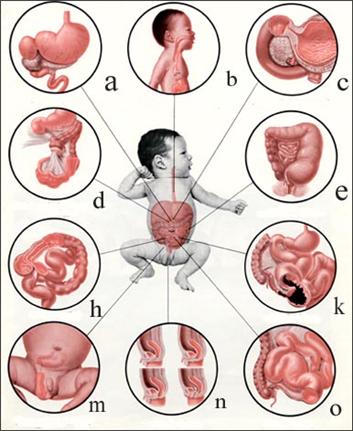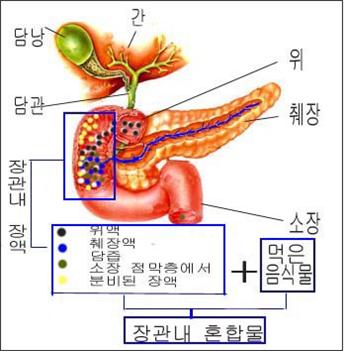신생아나 영유아에게 생길 수 있는 식도나 소대장의 폐쇄증, Esophagus or Intestinal obstructions in newborns or infants

▴ 그림 1-37. 신생아들과 영유들에게 생길 수 있는 장 폐쇄와 그 원인
a-윤상 췌장,
b-선천성 식도 폐쇄증과 기관식도 루(기관 식도 샛길),
c-비후성 유문 협착증,
d-장축염증,
e-선천성 거대결장,
h-장중첩증,
k-태변성 장 폐색증,
l-오른쪽 감돈된 서혜부 탈장증,
m-여러 종류의 쇄항증,
n-소장 폐쇄증
소스– Ross Laboratories, Columbus, Ohio 43216 와 소아가정간호백과
-
식도관, 소장관이나 대장관의 일부분이나 여러 부분이 여러 가지 원인으로 인해 완전히, 또는 불완전하게 폐쇄되는 병을 장폐쇄증이라 한다.
-
장액이 장관의 점막 층에서 끊임없이 장관 내로 분비되고 장관 내 장액은 장관의 점막 층을 통과해 장관 내에서 혈관 속으로 끊임없이 정상적으로 흡수된다.
-
장관의 일부분이 완전히 폐쇄되면 폐쇄된 장관 부분의 위쪽에 있는 장관 내 장액 및, 또는 먹었던 음식물이 폐쇄된 장관 부분을 통과해 그 아랫쪽으로 더 이상 내려 갈 수 없다. 즉 폐쇄된 장관 부분의 아래쪽에 있는 장관 내로 더 이상 내려갈 수 없다.
-
폐쇄된 장관 부분이 있는 위쪽에 있는 장관 내에 있는 장액 및, 또는 먹은 음식물이 폐쇄된 부분의 아래쪽에 있는 장관 내로 더 이상 내려가지 못할 때 장관 연동이 정상 이상으로 더 강력하게 생긴다.
-
폐쇄된 장관 부분의 이상에 있는 장관 내 장액과 먹은 음식물이 섞인 장관내 혼합물은 폐쇄된 장관 부분의 위쪽에 있는 상부 장관 내에서 폐쇄된 장관 부분의 이하에 있는 장관 내로 이동되지 못한다.

그림 1-38. 소장관 내 장액과 먹은 음식물이 섞인 혼합물.
- 구토할 때나 설사할 때 장관 내 혼합물이 위장관 점막 층을 통과해서 혈관 속으로 흡수되는 대신 체외로 나간다. 출처; 소아가정간호백과와 Glaxo Wellcome
-
장관의 일부가 완전히 또는 불완전하게 폐쇄되면 폐쇄(막힘) 장관 부분의 위쪽에 있는 장관 내에 있는 장관 혼합물(보통, 먹은 음식물, 췌장액, 답집과 장액이 섞인 혼합물)을 막힌 장관 부분의 이하에 있는 장관 내로 내려 보내기 위해 장관 연동이 훨씬 더 강하게 생긴다.
-
이런 장관 연동은 간헐적으로 생긴다. 이때 복통도 장관 연동 주기에 따라 간헐적으로 생긴다. 연동 주기에 따라 매우 심하게 배가 아프다가 안 아프다 한다. 즉 아프다가 안 아프다가 하는 주기적 복통이 간헐적으로 반복될 수 있다.
-
적절하게 응급 치료를 하지 않으면 이런 복통이 간헐적으로 계속된다. 점점 시간이 더 지나가면서 복통이 더 심해진다.
-
이때 구토를 동반하는 것이 보통이다.
-
마지막으로 폐쇄된 위장 관 부분이 심하게 붓고 거기서 점액이 분비되고 피가 나고 결국 점액 대변 및, 또는 혈변을 눌 수 있다.
-
적절히 치료하지 않으면 장관 벽이 천공될 수 있고 쇼크에 빠져 죽게 된다. 복통 참조
Esophagus or Intestinal obstructions in newborns or infants신생아나 영유아에게 생길 수 있는 식도나 소대장의 폐쇄증

▴ Figure 1-37. Bowel obstruction and causes in newborns and infants.
a-Annular pancreas,
b-congenital esophageal atresia and tracheoesophageal fistula (tracheal esophageal sideways),
c-hypertrophic pyloric stenosis,
d-volvuls of intestine,
e-congenital megacolon,
h-intussusception,
k-meconium intestinal obstruction,
l-right strangulated inguinal hernia,
m-several types of anal atresia
n-small intestine atresia
Source- Ross Laboratories, Columbus, Ohio 43216 and Pediatric Home Nursing Encyclopedia
- Intestinal obstruction is a disease in which the esophagus, the small intestine, or a part or various parts of the colon are completely or incompletely closed due to various causes.
- Intestinal fluid is constantly secreted from the mucous layer of the intestine into the intestine, and the intestinal fluid passes through the mucous layer of the intestine and is constantly absorbed into the blood vessels in the intestine.
- When a part of the intestinal tract is completely closed, the intestinal juice and food in the intestinal tract above the closed intestinal tract can no longer go down through the closed intestinal tract.
- In other words, it is no longer possible to descend into the intestine below the closed intestine part. Intestinal peristalsis occurs more strongly than normal when the intestinal fluid and food eaten in the intestine above the closed intestine section can no longer descend into the intestine below the closed section.
- Intestinal mixtures of intestinal fluid and food eaten above the closed intestinal section cannot be transferred from within the upper intestine above the closed intestinal section into the intestinal tract below the closed intestinal section.

- Figure 1-38. A mixture of intestinal fluid in the small intestine and food eaten. When vomiting or diarrhea, the mixture in the intestine passes through the mucous layer of the gastrointestinal tract and goes out of the body instead of being absorbed into the blood vessels. Source; Pediatric Home Nursing Encyclopedia and Glaxo Wellcome
- When a part of the intestine is completely or incompletely closed, the intestinal mixture (usually, a mixture of food eaten, pancreatic fluid, and a mixture and intestinal fluid) in the intestinal tract above the closed (blocked) part of the intestine is transferred into the intestinal tract below the obstructed intestinal part. In order to send down, the intestinal interlocking is much stronger. Such intestinal linkages occur intermittently.
- At this time, abdominal pain also occurs intermittently depending on the intestinal peristalsis cycle.
- Depending on the peristaltic cycle, it is said that the stomach hurts very badly and then does not. In other words, periodic abdominal pain that hurts and then doesn’t hurt can be repeated intermittently.
- This abdominal pain continues intermittently unless adequate emergency treatment is given. As time goes by, the abdominal pain gets worse.
- This is usually accompanied by vomiting.
- Finally, the part of the gastrointestinal tract that is closed is severely swollen, where mucus is secreted and bleeding, which can eventually press the mucous feces and/or bloody stool.
- If not treated properly, the intestinal wall can be punctured and shocked and killed.
- See abdominal pain
출처 및 참조 문헌 Sources and references
- NelsonTextbook of Pediatrics 22ND Ed
- The Harriet Lane Handbook 22ND Ed
- Growth and development of the children
- Red Book 32nd Ed 2021-2024
- Neonatal Resuscitation, American Academy Pediatrics
Emergency Medical Service for Children, By Ross Lab. May 1989. p.10
Emergency care, Harvey grant, and Robert Murray
Emergency Care Transportation of Sick and Injured American Academy of Orthopaedic Surgeons
Emergency Pediatrics A Guide to Ambulatory Care, Roger M. Barkin, Peter Rosen
Quick Reference To Pediatric Emergencies, Delmer J. Pascoe, M.D., Moses Grossman, M.D. with 26 contributors
Manual of Emergency Care 응급환자관리 정담미디어
소아가정간호백과-부모도 반의사가 되어야 한다, 이상원 저
The pregnancy Bible. By Joan stone, MD. Keith Eddleman, MD
Preparation for Birth. Beverly Savage and Dianna Smith
임신에서 신생아 돌보기까지. 이상원
Breastfeeding. by Ruth Lawrence and Robert Lawrence
The Johns Hopkins Hospital, The Harriet Lane Handbook, 18th edition
Red book 29th -31st Ed 2021
Nelson Text Book of Pediatrics 19th-21st Edition
Infectious disease of children, Saul Krugman, Samuel L Katz, Ann A. Gershon, Catherine Wilfert
The Harriet Lane Handbook 19th Edition
Growth and Development of Children, George H. Lowrey 8th edition
소아과학 대한교과서
제1권 소아청소년 응급의료 참조문헌과 출처
Other
Copyright ⓒ 2015 John Sangwon Lee, MD., FAAP
“부모도 반의사가 되어야 한다”-내용은 여러분들의 의사로부터 얻은 정보와 진료를 대신할 수 없습니다.
“The information contained in this publication should not be used as a substitute for the medical care and advice of your doctor. There may be variations in treatment that your doctor may recommend based on individual facts and circumstances. “Parental education is the best medicine.”